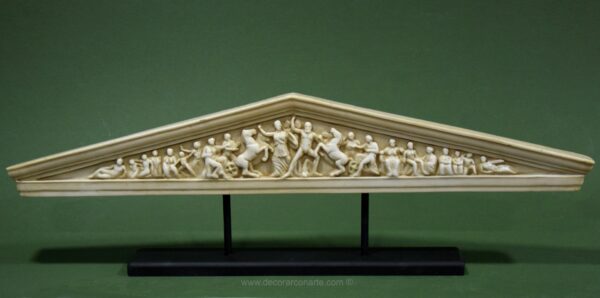Description
West Pediment Relief of the Parthenon. Reproduction of a relief in molded marble (marble powder with resins). The finishing is done with aging patinas based on natural earth that give it the texture and appearance of an ancient sculpture embellished by the passage of time.
Relief of the Parthenon of Athens on base.
Measurements: Length: 77 cm; Total height: 25 cm;
Reproductions of sculptures and reliefs, inspired by original pieces from museums. Classical art of Ancient Greece. Handmade in Spain. Ideal for interior decoration (living rooms, lobbies, libraries, and offices). Piece suitable for outdoor placement, on terraces and in gardens, weather-resistant.
West Pediment Relief of the Parthenon of Athens. Bas-relief reproduction. The original sculptures are housed in the British Museum, London.
These sculptures correspond to the sculptural ensemble of the pediment that was located above the secondary entrance of the Parthenon, composed with sculptures of the Olympian gods by the Athenian sculptor Phidias. It depicts the dispute between the gods Athena and Poseidon for the patronage of Athens. In the center are the gods protagonists of the myth: Athena on the left and Poseidon on the right, with an olive tree between them.
According to the myth, Athena offered the olive tree to the city’s inhabitants in exchange for being chosen as their patron goddess. The gift offered by Poseidon was the horse, and according to other versions, a spring of saltwater that the god made gush by striking the ground with his trident. The citizens ultimately chose Athena, from whom the city took its name, Athens.
The sculptures of the Parthenon, from the temple of Athena Parthenos on the Acropolis of Athens, were made by the school of Phidias in the 5th century BC (447 BC to 438 BC) in Pentelic marble. The sculptural ensembles that were part of the temple included: the two pediments East and West, which showed the birth of Athena and the dispute with Poseidon respectively; the metopes, located below the pediments, with scenes of the battle against the centaurs and the Amazons; and the friezes, bas-reliefs that surrounded the perimeter of the cella.











Reviews
There are no reviews yet.